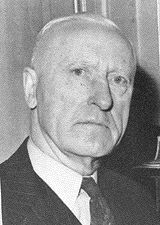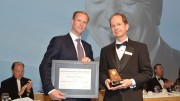Former University of Toronto professor J. Tuzo Wilson is among four new inductees into the Canadian Mining Hall of Fame. All four will be honoured at an awards banquet on Jan. 20, 2005, at the Fairmont Royal York Hotel in Toronto.
Wilson, who helped advance the theory of plate tectonics, will be joined by Alan Kulan, who made several noteworthy discoveries in Yukon, including the Faro base metals deposit, Adolphe La Prairie, an inventor of mine blasting techniques, and W. Austin McVeigh, who found the veins that would become the Madsen gold mine in Red Lake, Ont.
The evening will be hosted by Chris Hodgson, president of the Ontario Mining Association and a former minister of the province’s Northern Development and Mines.
J. Tuzo Wilson (1908-1993)
One of the world’s most renowned earth scientists, Wilson made significant contributions to the understanding of the dynamic earth, particularly in the fields of geology and geophysics.
While most famous for advancing the theory of plate tectonics, Wilson was also a practical scientist. He was one of the first geologists to use remote sensing and geophysics. Furthermore, during the early stages of his career, he delineated the provinces of the Canadian Shield. Each of these contributions has had an impact on mineral exploration and mine development in Canada and around the world.
Wilson was born in 1908, the son of a Scottish engineer who was a civil servant in charge of civil aviation. He graduated with a degree in geology from the University of Toronto and later earned his PhD in geophysics at Princeton. While at school, he also obtained a private pilot’s licence.
His interest in flying proved timely when he was an assistant geologist working for the Geological Survey of Canada in the late 1930s. He was one of the first geologists to employ air photography. He used air photographs as a supplement for the reconnaissance mapping of expansive regions in the Canadian Shield. As a result of his experience, he served as one of five members of a committee that published the first tectonic map of Canada in 1950.
In 1946, following his service in the Second World War with the Canadian Army Engineers, Wilson was appointed professor of geophysics at the University of Toronto. It was during his 28 years at the university that his most significant contributions to plate tectonic theory were made. He explained mantle plumes forming hotspot volcanoes, the existence and nature of ocean-floor transform faults, and the closing and reopening of ocean basins.
Wilson was also a skilled administrator, encouraging academic excellence and the pursuit of knowledge by others. From 1967 to 1974, he was the first principal of Erindale College, now known as the Mississauga campus of the University of Toronto. Following his retirement from the university in 1974, he became director general of the Ontario Science Centre until 1985, and was chancellor of York University from 1983 to 1986.
Wilson co-authored six books and published extensively, and received many honours and awards. During the Second World War, he was appointed an officer of the order of the British Empire and received the American Legion of Merit. In 1974, he was appointed a companion of the Order of Canada. In total, he was awarded 15 honorary degrees from Canadian and U.S. universities.
Alan Kulan (1921-1977)
Credited with the discovery of several sizable lead-zinc-silver deposits in the Yukon, most notably the renowned Faro deposit, Kulan was a pioneering prospector with an independent, entrepreneurial spirit. His successes spawned other ventures, such as prospecting syndicates and exploration companies, which, in turn, led to the discovery of other notable deposits and significant mineral occurrences. He also helped educate others and supported the development of communities in the Yukon.
A native of Toronto, Kulan spent most of his early years in Beausejour, Man., before enlisting in the Canadian army in 1939. After the war, he opted for self-employment and so took up prospecting. He was one of the first prospectors to venture into Yukon, even though few, including the Geological Survey of Canada, thought the territory had much mineral potential. Mining executives also shied away, thinking the logistics would be too onerous.
In July 1953, Kulan found a heavy concentration of rust close to Vangorda Creek, near Ross River, and further prospecting resulted in major lead-zinc discoveries. During this time, he helped educate locals, especially indigenous peoples, about prospecting and mineral identification. His success helped build Ross River by establishing permanent office facilities, an assay lab, and a courier service, as well as a hotel and general store. He also rewarded those who had helped him succeed by giving them 40,000 shares of Prospector Airways.
In 1964, Kulan helped form Dynasty Explorations and set about searching for base metals around the Vangorda area. When the company needed more funding, Dynasty joined with Cyprus Mines to form Anvil Mining, which discovered the Faro deposit. The Faro mine operated for more than 20 years and established the Yukon as a major supplier of base metals.
After Faro, Kulan formed, ran and managed several mining and exploration companies. He would often get things under way, then fade into the background and eventually relinquish control to continue prospecting.
In later years, while examining iron ore deposits in the Blow River-Rapid Creek and Cross Cut Creek area, he re-discovered some of the world’s best specimens of lazurite and a source of new phosphate minerals, which to date have not been found anywhere else. These discoveries led to the Alan Kulan Memorial lectures, sponsored jointly by the University of Toronto, the Yukon Chamber of Mines and the Yukon Geoscience Foundation.
Kulan was killed in a shooting in Ross River, Y.T., in 1977.
Adolphe “Lap” La Prairie (1893-1976)
Adolphe “Lap” La Prairie is well known for the technical innovation he brought to the Canadian explosives and mining sectors. His goal was simple: to make mining safer and more efficient.
La Prairie joined CXL, the forerunner to CIL Explosives, in 1918 and quickly became a well-respected blasting expert who spent time discussing blasting practice with anyone who would listen. He was assigned to the Timmins, Ont., area as a manager in 1920 and spent most of the next 20 years there solving blasting problems.
Some of his innovations were simple and based on common sense. He was credited for starting the practice of dipping the cut ends of safety fuse assemblies in order to help identify which fuses had been trimmed. This practice reduced confusion during the hole-loading process and saved time. The practice is now commonplace.
Other innovations La Prairie devised were more technical, such as the air curtain, which is still used by civil and mining engineers during underwater construction projects.
While working in the Timmins camp, he noticed that dynamite functioned differently depending on ground conditions. As a result, he developed different formulations of dynamite, including a particular formula that would function better in the schistose ground near Timmins. This new formula, Polar Forcite 60%, quickly became the preferred explosive underground.
La Prairie’s concern for miners extended beyond the workplace and into the communities in which they lived. He was involved in many community activities, but perhaps the most significant involved the organization and promotion of “Lap’s Turkey Stag,” which was the forerunner of the Santa Claus Fund in Timmins.
In addition to charitable events, La Prairie is credited with inaugurating, in 1922, one of the Canadian mining industry’s most significant social engagements: the Annual Oyster Party. Owing to its popularity, the event soon spread to other communities, including Toronto in 1934.
W. Austin McVeigh
(1882-1975)
W. Austin McVeigh was one of 10 children born to farmers on Grand Calumet Island, Que., near Ottawa. It was here that he developed his love of the outdoors and dr
eamed of the riches being discovered in places such as Cripple Creek, Colo., and Cobalt, Ont.
Before the First World War, he started searching for silver and gold in the Cobalt and Kirkland Lake areas of northern Ontario. He soon learned the basics of geology, mining and mineral valuation and developed a knack for sampling. In 1926, news of a gold strike sent him west to Red Lake, Ont.
In 1934, McVeigh was prospecting around an active claim group in Red Lake and discovered a gold-bearing volcanic tuff and breccia formation. His thoroughness and precision while taking the cut channel samples paid off and the first hole drilled into the discovery intersected 27 ft. assaying $7 gold per ton. That work led to the discovery of the Austin, McVeigh and South Austin veins, which would later become the Madsen gold mine. During its 38 years in operation, Madsen Red Lake Gold Mines produced more than 8 million tons of ore and paid its shareholders more than $10 million in dividends.
In 1938, McVeigh continued west to Manitoba and began prospecting exclusively for Sherritt Gordon Gold Mines.
In 1941, he was prospecting for gold about a quarter of a mile north of what would become Lynn Lake when he noticed iron staining in gabbroic rocks. The outcrop was sampled and yielded assays of 1.5% nickel and 1% copper. The remoteness of the discovery, almost 120 miles from the nearest town in the middle of a bog, dampened the company’s enthusiasm, and further work was suspended. Undaunted, McVeigh returned in 1943 and, with a magnetometer, outlined three other anomalies near the original discovery. Drilling commenced, and the third hole intersected 84 ft. of ore-grade mineralization in what was to become the Upper A orebody of the Lynn Lake mine. Eventually five orebodies containing more than 14 million tons were outlined.
The nickel and copper deposits of Lynn Lake were among the richest deposits in the world. Their richness enabled the establishment of a townsite, railway and mine complex and injected about $14 million annually into the Canadian economy.
The Lynn Lake development also led to a surge in exploration, allowing Sherritt Gordon to prosper and become Sherritt International, and Lynn Lake to develop into a hub for future mineral exploration in Manitoba and Saskatchewan.
McVeigh was a highly skilled and widely respected Canadian prospector. While famed for his discoveries at Red Lake and Lynn Lake, he made many other, lesser known, discoveries, which were stepping stones to future mines.
For information about tickets to the Hall of Fame banquet, contact John Cooke at (905) 339-0898. Or visit www.halloffame.mining.ca





Be the first to comment on "Tuzo Wilson among four new inductees to Canadian Hall of Fame"